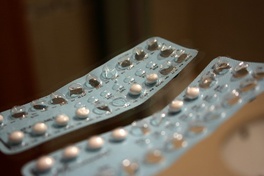
Only an Austrian man could have helped invent the pill
Published on
Translation by:
Karis EaglestoneA new generation of young women who are fed up with ingesting a concoction of hormones every day are in search of an alternative to the oral contraceptive as a contraceptive method. Reflections on the occasion of international women’s day on 9 March. Testimony from a young female
‘Only a man could have invented the pill’, is Luise’s theory, 'because they are free while women actually endorse responsabilty of contraception in the couple.' The fact is that my interviewee actually has a man to thank for the pill - namely the Austrian chemist Carl Djerassi, who in 1951 applied to patent a derivative of the sex hormone progesterone. With that, the contraceptive pill was born.
The pill programmes the body into a sort of artificial pregnancy
Also fact is that the pill programmes the body into a sort of artificial pregnancy, as the very hormones that are contained in the pill are those that are naturally produced by the female body in order to regulate the monthly cycle, just as the course of a pregnancy. It is precisely these natural processes that are affected by the pill. In which case, Luise can’t be so far off the mark. Even if her comparison might be a little clumsy, she’s only expressing the anxiety felt by a number of young women who ask themselves if protection against unwanted pregnancy really has to mean taking a dosage of hormones every day. Could it in fact be true that the pill interferes with the natural cycle to such an extent that - as some critics warn - it could affect permanent infertility – and moreover not just in the case of women?
The Vatican and the contraceptive pill at loggerheads
 A study published at the beginning of January 2009 asserted that ‘we can look to environmental pollution incurred by mass usage of the contraceptive pill as an unnegligible cause of male sterility in the western world.’ One could confidently dismiss this thesis - borne to the public by the president of the federation of catholic medical associations, Jose Castellvi - as a polemic. It does, among other things, refer to the inventor of the pill in person.
A study published at the beginning of January 2009 asserted that ‘we can look to environmental pollution incurred by mass usage of the contraceptive pill as an unnegligible cause of male sterility in the western world.’ One could confidently dismiss this thesis - borne to the public by the president of the federation of catholic medical associations, Jose Castellvi - as a polemic. It does, among other things, refer to the inventor of the pill in person.
In the Austrian national daily Standard, Djerassi recently attested his invention to have contributed to ‘demographic catastrophe’. It doesn’t take much imagination to claim that as an effective means of birth control, the contraceptive pill is an underlying factor to the dwindling birth rate in the western world. The new and somewhat bold hypothesis is based on data from a hospital in Stans, the capital of the canton of Nidwalden in Switzerland. It says that that the ‘tonnes of hormones’ that are dispensed into our water supplies on a yearly basis also burden the male food chain with increased hormone levels. Bye bye libido?
Such new pieces of knowledge are of no consequence to Luise though, for whom it has been clear for a long time that the pill can have worldwide side-effects on health. She backs her choice of a natural alternative with knowledge gained by scientists based at the university of Massachusetts. They suggest that even years after giving up the pill as a contraceptive method, changes due to the hormone treatment remain noticeable. A diminished libido often reflects this. The scientists also warn however, that very prolonged and constant use of the pill (at least over fifteen years) can lead to infertility.
Naturally pleasurable
Luise uses the so-called basal body temperature method. The online encyclopedia Wikipedia describes this as outdated, as it relies solely on precise observation of body temperature during the monthly cycle. In the case of the basal body temperature method however, the Pearl index (which indicates the reliability of the various contraceptive methods) rests at 1 to 5 – that is to say, 1 to 5 out of 100 women relying on the method become pregnant. Which isn’t bad at all, considering that on the Pearl index the condom – approved as one of the safest contraceptive methods - stays at 0.9 to 14. This range arises as a result of the uncountable application errors that can occur when using condoms. The same goes for Luise’s alternative: only those who carefully abide by the general conditions have hope of success.
Additionally, the body temperature must always be measured at approximately the same time – after waking up and before getting out of bed. After at least five hours of sleep, and without having recently consumed alcohol, taken medicine or had a cold. Is that really the lifestyle of someone in their mid-twenties though? The research is well on its way – or is it?
Despite everything, only few make the consequences of their discontent known, like Luise. Worldwide, the pill is the most popular contraceptive method, next to the condom. It is the most frequently used contraceptive in Germany at 48%, followed by Holland (41%) and Hungary (37%).
The pill is most frequently used contraceptive in Germany (48%), followed by Holland (41%) and Hungary (37%)
Speculated alternatives to the pill such as the ‘male pill’ are just not in sight yet, despite having been in discussion for a long time. Since 2007, research has taken a back seat, after the last active pharmaceutical company in Germany, Bayer-Schering, also withdrew from further research. ‘We have no assurance that this product is marketable,’ was the objection heard from company circles at the time. The results were said to have been proven; the use of the product, however, pronounced too complicated. In any case: ‘I’m not sure if I would in fact leave contraception up to a man. Somehow this responsibility seems so feminine to me that I find it difficult to think otherwise,’ confesses Luise.
Translated from Die Pille muss ein Mann erfunden haben!



